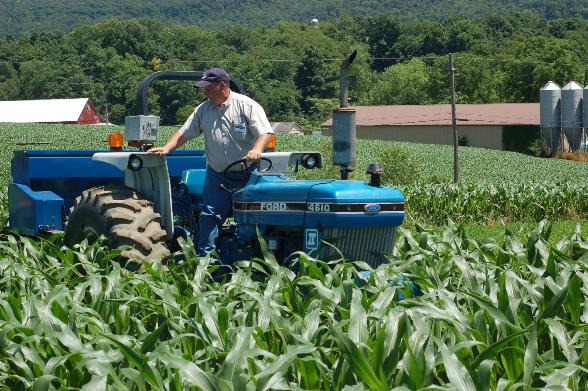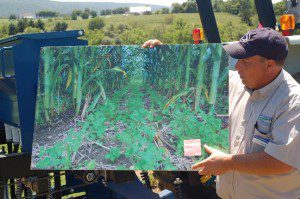
King’s AgriSeeds collaborates with various groups that share our goals of crop research and farmer education. One example of our collaboration is field days. We have already hosted multiple field days this year and will continue to do so as the seasons change and standing crops vary. This article highlights a recent field day hosted by multiple collaborators. Mill Hill Farm Supply, King’s Agriseeds Inc., The PA No-Till Alliance, Blair County Conservation District, USDA-NRCS, PADEP’s Chesapeake Bay Program and Penn State Extension collaborated on a comprehensive two day “Summer Cover Crop & Soil Health Workshop” at Jim Biddle’s Mill Hill Farm location (a King’s AgriSeeds dealer in Williamsburg, PA) in mid June.
Speakers dug deeper than standard topics of soil health benefits from cover crops and delved into technical discussions of cover crops in context and facing the challenges of making them work. Dave Wilson, King’s Research Agronomist, spoke about planting into residue – a prevalent challenge of fitting cover crops into an established rotation, especially for no-till operations. Forage rotations with heavy previously fall planted winter-annual crop that was spring harvested for baleage has a much heavier root residue and is much different to no-till into compared to a previous year’s dead crop stubble or even a low-rate seeded cover crop.
Emphasis was placed on the need for effective row cleaners, having enough weight for coulters to cut through residues, planting depth control, the importance of seed to soil contact, and effective row closing devices.
The audience wondered about the best stage to plant into the remains of the previous crop – plant green and spray? Spray and wait until it is dead? What is the correct timing of planting and spraying?
Planting into green residue and then spraying is optimal, since there will be less hairpinning (when crop residue gets bent and pinned in the furrow, preventing seed to soil contact). Cover crops that are green, living and standing are ideal for planting into. Plant into them just prior to spraying or just after spraying. Hairpinning can be a major obstacle in no-till planting scenarios during that in-between time – after the crop is a sprayed and begins to die off, but before it gets dry and crunchy. During this phase it is the most rubbery, wirey and difficult to cut through.
Smaller 4 row no-till corn planters need more weight compared to larger 6 and 12 row planters. The larger planters have more weight in the tool bar and this helps cut through heavier residues. Some newer planting units have heavy down pressure springs which can be adjusted to apply this down pressure to cut. Older planting units and smaller units float on top and you probably need to add some weight to the unit to achieve sufficient down pressure to cut. In King’s research trials, three 90 lb suitcase weights were added to each unit (270 lbs per planting unit) in the insecticide box to achieve proper seed trench cutting action into the no-till cover crop residue with the smaller 4-row no-till planter. If this hadn’t been done, many seeds would have been on top instead of down in the planting furrow. The scenario is different with larger units.
Other forms of residue management and timing were discussed. A fall manure application is a useful tool to lower the carbon to nitrogen ratio and break down residue quicker, but this still needs a few months to happen. UAN applications are also an option for speeding residue breakdown.
Another discussion topic covered was renovating pastures with summer annuals such as sorghum-sudan. Seeding a summer annual for forage use can also double as a break crop, breaking pest and weed cycles. The standard issues arose again – how to manage residue from the previous crop while getting the new crop going?
There were also concerns about the rotation following the cover crop – fitting in a corn planting after terminating a winter annual cover crop. One underappreciated fact is that early planted corn doesn’t always have the edge. Depending on the weather of a given year, the hybrid genetics, and many other factors, late planted, shorter season corn can outyield the earlier planted corn, especially since that earlier-planted seed may sit in the ground for quite awhile before it comes up. In a late spring, giving up an early planting loses relatively few growing degree days, and planting later gives up a little more, but a later planting gets so many heat units all at once that it can catch up quickly and yield more. The seed is out of the ground much faster and on its way, as soil temperatures warm up. On larger farms, timing becomes more critical and available planting windows can be tighter.
Interseeder Technology
Dave Wilson and Chris Houser Penn State Education Educator presented information about the Interseeder. Dave has been collaborating with the PSU group since 2011

with this project, and King’s Agriseeds has been supporting the on-farm research for the project supplying cover crop seeds for research and on-farm demos at multiple locations.

The Interrow Seeder technology can allow a cover crop to be no-till drilled into standing 30-inch corn or soybeans at last cultivation, adding flexibility to a rotation where the growing season is shortened by climate or other constraints.
Cover Crop Mixes and Nutrient Cycling
Penn State’s Charlie Whitespoke about cover crops and nutrient cycling. Charlie compared various cover crop mixes, how they vary in their nutrient cycling capabilities, their carbon to nitrogen ratios and later release of nutrients back to the following crop in rotation. Charlie presented various on-farm research results from no-till applications, which contributed to the bigger picture of understanding how to make cover crop mixes fit in rotation and how they can be an integral part of a nutrient cycling and nutrient management program.
Attention was drawn to fundamental differences among cover crop types. Grasses and forbs take up and retain N, while legumes have the complementary function of fixing N. Many growers use this to their advantage when formulating mixes; grasses and brassicas tend to grow quickly and can take up and hold N in their tissues, while legumes grow slowly. The quickest growing species can take up and hold N, preventing it from leaching, and will supply it to the slower species as they die and decompose. This provides important justification for incorporating as much diversity as possible into the cover crop mix. As would be expected, legumes do a poor job (compared to grasses) of preventing nitrate leaching.
Crops such as sorghum-sudan is an excellent phosphorus scavenger, and buckwheat is a good option for making phosphorus more available in soil.
Crops with high carbon to nitrogen (C:N) ratios temporarily tie up soil nitrogen until they break down, another consideration if the crop is being grown to supply nutrients to a following crop, or if a relay or “planting green” sequence is planned.
If there are concerns that the cover crop is lignifying too quickly, a mix with another species, such as a legume, greatly reduces the ratio. The ideal C:N ratio for a cover crop to break down and “give back” coincides closely with the level of quality, in terms of metrics like NDFd and protein, that would optimal for forage – good to consider if the cover crop will be dual purpose.
Mixing nitrogen producers like clover in with grasses can be a poor choice if you are planning for a certain level of N production, because clovers are often poor competitors in a thick crop such as ryegrass. Seeding rates need to be carefully considered, keeping rates for less competitive species on the higher side. The physical structures of various species should always be considered in mixes, not just their biochemical functions. Radish, for example, should always be limited to a low rate because it forms a very aggressive canopy. If planted in a straight stand, however, a high rate causes them to grow thinner and drill down deeper, exacerbating their scavenging and “bio-drilling” function.
Jim Biddle, the King’s dealer and host for the on-farm portion of the event, favors cover crop cocktail use on his own farm, though, because “something in the mix has to work and go right.”
Jim is a faithful no-tiller, and believes “the longer you no-till and cover crop, the quicker the residue will disappear, because you get increased microbial activity.”
If you are interested in learning more about our field days or those of our collaborators, see the events section at the bottom of our homepage (kingsagriseeds.com).
Speak to an expert at King’s AgriSeeds now at 1-717-687-6224 or email us at [email protected].
